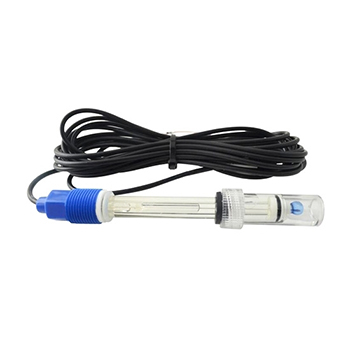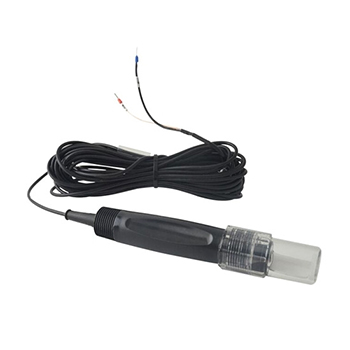How do I Calibrate pH Probe Electrode?
All pH electrodes require frequent calibration, and two-point calibration makes the electrode and a specific host form an accurate test system. Follow the steps below to complete the two-point calibration. The calibration process will be described below by taking the 7.00 and 4.01 standard solutions as examples.
Calibration method
- Rinse the electrode with distilled water to remove any remaining liquid, such as storage solution, process medium, or the last test solution. After removing the standard solution from the electrode, rinse it thoroughly with distilled water to prevent cross-contamination of the standard solution. Carefully wipe off any remaining distilled water on the electrode with a damp cloth (fiber type). The glass sensing film should never be scratched to prevent static buildup.
- Insert the electrode and ATC (automatic temperature compensation probe) into the pH 7.00 standard solution and wait for 30 seconds to allow the electrode and temperature probe to reach thermal equilibrium, which is the same temperature as the standard solution. Adjust the host reading to 7.00 or display 7.00 during automatic calibration.

- Note: If the host does not have ATC, insert the thermometer and pH electrode into the pH 7.00 standard solution and wait for 30 seconds to allow the electrode and thermometer to reach thermal equilibrium, which is the same temperature as the standard solution. Input the measured temperature value from the host, and then adjust the host reading to 7.00 or 7.00 is displayed during automatic calibration.
- Repeat step 1, insert the electrode and ATC into the 4.01 standard solution, after 30 seconds, adjust the reading of the host to 4.01 or display 4.01 during automatic calibration.
- Repeat steps 2 and 3 to improve the accuracy of the correction. Always use fresh standard solutions to achieve the best test results.
- In step 3, the pH 10.00 standard solution can also be used instead of the 4.01 standard solution. However, when the standard solution with pH>7 is not stable, the service life is relatively short. Because alkaline solutions absorb carbon dioxide, the pH drops when exposed to air. Therefore, it is recommended to use a standard solution of pH 4.01 to complete a stable two-point calibration. In addition, the pH of the standard solution should cover the pH value of the solution to be tested. If the host has an automatic calibration function, please refer to the relevant operating instructions of the host.
pH Electrode Cleaning Procedure
The following three cleaning procedures are particularly effective for polluted electrodes, almost 90% of the polluted deposits can be cleaned with detergent, warm water, and remove with a soft brush.
Washing pH Electrode Glass Bulbs
Wash with a warm, neutral detergent solution. Brush the glass bulb lightly with a soft brush, then wipe it with a clean cotton or cloth dipped in the solution, rinse thoroughly with distilled water, and soak in saturated KCL solution for at least 30 minutes.
Inorganic sediment
Soak the glass bulb of the pH glass electrode in dilute HCL solution for a few minutes (note: only on the top of the glass bulb), then clean it with distilled water, and immerse it in 3.8M KCL solution for no less than 30 minutes.
The calibration interval of the pH electrode depends on the respective process. The more stable the process conditions (temperature, pressure, composition, no fouling, etc.), the more stable the pH measurement and the longer the calibration interval. Most pH electrodes require calibration on a weekly or monthly basis. Under the premise of ensuring accuracy, calibrate more frequently at the beginning, and then gradually extend the calibration interval.
The frequency of electrode calibration and calibration depends on the sample, electrode performance, and measurement accuracy requirements, and is also related to the PH use environment and service cycle. For high-precision measurement (≤±0.03pH), it should be calibrated in time; for general precision measurement (≤±0.1pH), it can be used continuously for two weeks or even longer after one calibration.
Test the standard solution that is close to the measured solution before determining, and determine whether recalibration is required according to the size of the error. In the following cases, it must be recalibrated:
- Electrodes used for a long time.
- After the electrode measures concentrated acid (pH<2), or after measuring concentrated alkali (pH>12).
- After measuring solutions containing fluoride or concentrated organic solutions.
- When the temperature of the measured solution is too different from the temperature of the standard solution (or room temperature).
Electrode maintenance
- If the pH combination electrode is not used at ordinary times, it can be soaked in 3mol/ KCL solution or saturated KCL solution. It is strictly forbidden to soak the electrode in distilled water, deionized water, or tap water with very little ion content.
- If the pH electrode is left dry for a long time and exposed to the air, before reuse, please soak the electrode in 3mol/ KCL solution or saturated KCL solution for 2~3 days to restore the activity of the electrode. If possible, please soak the electrode in the electrode regeneration solution for about 1 minute, then wash it with distilled water, and soak it in 3mol/l KCL or saturated KCL solution for at least 1 day before using it.
- If the electrode-sensitive membrane or the pores of the white ceramic diaphragm turn yellow due to protein contamination, you can purchase an electrode-cleaning solution. Soak the electrode in it for several hours, then wash it with distilled water, and finally, soak it in 3mol/l KCL or saturated KCL solution for at least 1 day before using it.
- If the white ceramic diaphragm hole of the electrode is polluted and turns black, you can buy a diaphragm cleaning solution, soak the electrode in it for several hours until the diaphragm hole turns white again, then wash it with distilled water, and finally soak it in 3mol/l KCL or Saturated KCL solution, at least 1 day before use.

